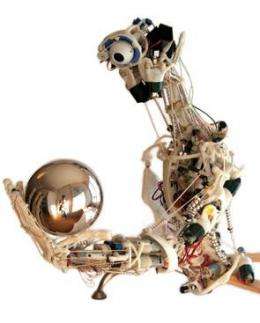April 7, 2010 report
Online e-expo features more than 100 university robotics labs

(PhysOrg.com) -- In an effort to bring together the top academic robotics labs under one roof, a project called EXPO21XX has created an online exhibition to showcase the diversity in today's robotics research. At one website, robotics researchers and enthusiasts can view the projects underway in more than 100 university robotics labs from around the world.
EXPO21XX, which has been providing electronic exhibitions (or e-expos) since 2001 for a variety of industries, launched the virtual University Robotics Platform in 2008. The e-expos offer a convenient and free alternative to the conventional expo by taking advantage of the internet and the latest multimedia technology.
Similar to a real-life expo, EXPO21XX’s e-expos are organized into halls, corridors, and individual stands. The University Robotics Platform, for example, is located in e-Hall05 of the Automation e-expo (where there are currently 37 e-Halls).
On the Universities Robotics Platform, you can learn about many different robotics projects that don’t always make it to the news headlines (and some that do). For example, visitors can watch videos of the following robots:
*A robotic jaw that simulates human chewing behavior, which was designed by researchers at the Mechatronics and Robotics Research Group at Massey University in New Zealand.
*A robot that uses Facebook, which was designed by researchers the Interactive Robots and Media Laboratory at the United Arab Emirates University.
*A robot that performs stereotactic microsurgery, which implants an electrode in the brain for a therapy called deep brain stimulation that could help treat Parkinson’s disease. The robot was designed by researchers at the Institute for Robotics and Cognitive Systems at the University of Luebeck in Germany.
*A giant six-legged ant-like robot that skitters across the ground and flips itself over to walk “upside down.” The robot was developed by researchers at the Active Structures Laboratory at the Université Libre de Bruxelles in Brussels, Belgium, for gait studies.
*A brain-actuated robotic wheelchair constructed by researchers at the Neurotechnology Lab at the University of Zaragoza in Spain. The wheelchair is being designed to provide people with severe neuromuscular disabilities with a certain degree of mobility.
Prominent among the presenters is Prof. Peter Bock of George Washington University (Computer Science) who was invited to publish a complete presentation of the functionality of ALISA (Adaptive Learning Image and Signal Analysis) and the results from his recent funded projects with Bosch and then DTRA (Defense Threat Reduction Agency of the DOD).
The Universities Robotics Platform continues to grow, with a few stands currently being reserved for additional universities. If you want to get a glimpse of the future, this is definitely worth checking out.
Visit the site at www.expo21xx.com/automation21xx/university.htm
© 2010 PhysOrg.com



















